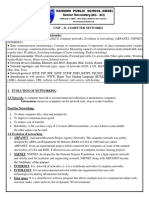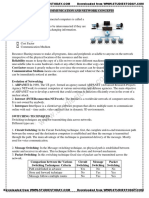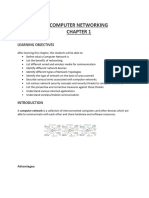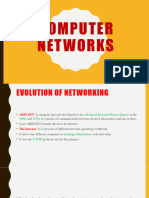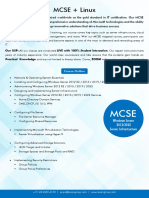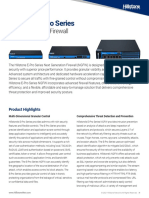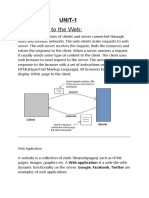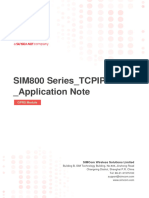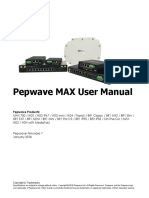COMPUTER SCIENCE-XII
UNIT- II, COMPUTER NETWORKS-10 MARKS
Network : A network is an interconnected collection of autonomous computers.
Autonomous means no computers on the network start, stop or control another.
Need for Networking :
1. To share computer files, data and peripherals.
2. To improve communication speed.
3. To reduce cost of transfer.
4. Reliability: A file can have copy of 2 or more different machine, so one of them is unavailable
the other copies can be used.
Evolution of networking :
1. ARPANET : (Advanced Research Project Agency Network): The computer network was jointly
designed by ARPA and Department Of Defence (DOD) of USA in 1969 and was called ARPANET. It
was an experimental project which connected few computers of some of the reputed
universities of USA and DOD. It allowed access and use of computer resource sharing projects.
2. INTERNET : It is network of networks i.e. it is a worldwide networks of computer networks.
3. INTERANET : It is an interconnected network within one organization that uses web
technologies for sharing information internally.
4. Inter space : It is a client/Server software program that allows multiple users to communicate
online with real-time audio, video and text chat in dynamic 3D environments.
Elementary Terminology of Networks :
1. Nodes(Work stations) : It refers to the computers that are attached to a network and are
seeking to share the resources of the network.
2. Server : It is a computer that facilitates the sharing of data, software and hardware resources on
the network
3. Network Interface Unit(NIU) : It is an interpreter that helps establish communication between
the server and workstations.( It is also called NIC(Network interface card ) or TAP (Terminal
Access Point))
Switching Techniques : are used for transferring data across networks.
3 types of switching techniques : 1. Circuit Switching
2. Message Switching
3. Packet switching
Page 1 of 18
�Circuit Switching : In this technique ,first the complete physical connection between two computers is
established and then data are transmitted from the source computer to the destination computer. This
technique provides end to end connection between computer before any data can be sent. It is
designed for voice communication.
Message Switching : It is similar to post office mailing system. In this technique, the source computer
sends data or the message to the switching office first, which stores the data in its buffer and then it
looks for a free link to another switching office and then sends the data to this office. This process is
continued until the data are delivered to the destination computers.
In this case the data access time is more because data packets are stored on the disc.
Packet Switching : In this technique, messages are broken into packets and send across the network
and they are collected and assembled at the destination. In this technique, the data access time is less
because the packets are stored in the main memory.
(OR)
In packet switching, a fixed size of data packet that can be transmitted across the network is specified
and then the data packets are sent through switching stations to the final destination. All the packets
are stored in the main memory instead of disk. As a result accessing time of packets is reduced.
Data communication Terminologies :
1. Data channel/Communication Channel/Transmission Media :
The medium through which data are transferred from one location to another.
Different communication media are :
(i) Twisted pair cable
(ii) Coaxial cable
(iii) Optical Fiber Guided Media
(iv) Ethernet cable
(v) Radio Wave
(vi) Micro Wave Unguided Media
(vii) Satellite
(viii) Infrared
2. Baud : It describes the rate of change of signal on the line i.e. how many times (per second) the
signal changes its pattern. ( 1 baud =1 bps (bits per second))
3. Band width : It is the difference between the highest and lowest frequencies of the transmission
channel.
In digital system , Band width is data speed in bps
In analog system, it is measured in Hertz.
4. Data transfer Rate : It represents the amount of data transferred per second by a
communication channel. It is measured kbps( killo bits per second),Kbps( killo bytes per
second),mbps, Mbps, gbps, Gbps, tbps,Tbps.
Transmission Media :
1. Twisted pair cable :
It consists of two identical wires wrapped together in a double helix.
It is used for telephone wiring
Merits :
1. It is very simple.
2. It is easy to install and maintain.
3. It is physically flexible.
Page 2 of 18
� 4. It has light weight.
5. It can be easily connected.
6. It is very inexpensive (i.e. cheap).
Demerits
1. Low Bandwidth
2. Easily pickup noise signals
3. It is incapable carrying a signal over long distance without the use of repeaters.(100
meter limit)
2. Coaxial cable : It contains two conductors that are parallel to each other.
Merits :
1. The data transmission of coaxial cables are better than of twisted pair cable.
(Higher band width)
2. They are used in cable networks and long distance telephone lines.
3. They are used for broadband transmission.
4. Offer higher bandwidth up to 400 Mbps
Demerits :
1. More expensive than twisted pair cable
2. They are not compatible with twisted pair cables
3. Optical Fibers :
Merits :
1. High bandwidth
2. Noise resistance
3. Zero electrical interference and complete electrical isolation.
4. Information is travelling on a modulated light beam.
5. They are used for broadband transmission where several channels are handled in parallel.
6. It is a secure transmission,
7. It is suitable for harsh industrial environments.
Demerits:
1. High cost (i.e. most expensive)
2. Difficult to install
3. Difficult for solder
4. Connection losses are common problem
5. Connecting two fibers together is a difficult process.
Ethernet Cable : An Ethernet cable is used on a wired networks. It connect devices within a local area
network like PC’s, routers and switches within a local area network. These cables are
limited by length and durability. If a network cable is too long or of poor quality, it won’t
carry a good network signals
Radio Wave :
Merits :
1. Radio wave transmission offers mobility.
2. It is cheaper than other media
3. It offers freedom from land owners right.
4. It penetrate the buildings.
Page 3 of 18
� 5. It is omnidirectional.
6. It is used for long distance communication.
Demerits :
1. It is an insecure communication.
2. It is susceptible to weather effects like rains, thunder, storms etc.
Micro Wave : it is an electromagnetic wave in the frequency range of about 1 to 300 GHz. It
transmits voice and data at 45 Mbps through the atmosphere. It is unidirectional.
Merits :
1. It is used to wide band communication system( telephone system, television transmission)
2. It is cheaper
3. Easy of communication
4. It offers freedom from land owner right.
5. It can communicate over oceans.
Demerits :
1. It is an insecure communication.
2. It cannot penetrate walls.
3. It has high cost of design, implementation and maintenance.
4. It has limited bandwidth allocation.
5. The signal strength may be reduced due to setting of antenna.
6. It is susceptible to weather effects like rains, thunder, storms etc.
Satellite :
Merits :
1. It covers large area.
2. It is useful for sparsely populated areas.
3. It is a commercial attractive.
4. It is a secure communication.
Demerits :
1. Very high cost
2. High atmospheric losses above 30 GHz limit carrier frequencies.
Note : The other communication Media are Infrared, Laser, Bluetooth, WIFI and Ethernet
Cable( are connect network devices such as MODEM, Router and adapters)
Infrared Waves :
Infrared waves, with frequencies from 300 GHz to 400 GHz, can be used for short-range
communication. They have high frequencies and cannot penetrate walls.
NETWORK DEVICES:
1. MODEM (Modulator-Demodulator) :Modulator convert a digital signal to analog signal and
demodulator convert an analog signal into digital signal.
A Modem is a computer peripheral that allows to connect and communicate with other
computers via telephone lines.
2. RJ-45 (Registered Jack -45) It is an 8 wire connector which is used to connect computers on the
local area network.
Page 4 of 18
� 3. Ethernet card( LAN card) : It is a hardware device that helps in connection of nodes within a
network.
4. Hub : It is a hardware device used to connect several computers together.
Two types of Hub :
(i) Active Hub: It provide path for the data signals and strengthen the signals
before sending to their destination. They are called repeaters.
(ii) Passive Hub: They have nothing to do with modifying the signals.
5. Switch : A switch is a device that is used to segment networks into different sub networks
called subnets or LAN segments.
6. Repeater : It is a device that amplifies a signal being transmitted on the network. It is used
for long distance transmission (i.e. above 70 meters)
7. Bridge: It is device that is used to connect two networks using in same topology and
same protocols.
8. Router : It is a device that is used to connect two networks using same topology
and different protocols.
9. Gateway: It is a device that is used to connect dissimilar network
( i.e. different topology and different protocols)
TYPES OF NETWORK : There are 4 types of networks.
1. Local Area Network(LAN)
2. Metropolitian Area Networks(MAN)
3. Wide Area Network(WAN)
4. Personal Area Network(PAN)
LAN : Small computer netwoks that are confined to a localized area (e.g. an office, a building or a factory
University Campus) are known as LANs.The key purpose of LAN is to serve its users in resource sharing.
Properties :
a) Diameter is not more than 10 Kms.
b) Use multi-access channels
c) Rate of transmission is high
d) Highly reliable(low error rates)
WAN: The network spread across the countries is known as WANs. A WAN is a group of computers that
are separated by large distances and tied together. (Example : Internet)
Properties :
a) Span entire countries
b) Use point-to-point link except satellite network
c) Rate of data transmission is slow.
d) Owned by multiple organization.
e) Low reliability(high error rates)
MAN : These are the networks that link computer facilitates within the city or town.( ie. Maximum 20
Kms of Diameter).It is in between LAN and WAN. It is a network that covers an entire city but uses LAN
technology.
Example : An organization can have multiple branches in the same city, One being the headquarter
building and other being normal offices in the same city.
Page 5 of 18
�PAN : It is the interconnection of information technology devices within the range of an individual person
i.e. within a range of 10 meters. Example : Wifi, Hotspot, Bluetooth
NETWORK TOPOLOGIES :
The pattern of interconnection of nodes in a network is called the topology.
Types of topologies : 1. Star Topology 2. Bus(Linear) Topology 3. Tree Topology
STAR TOPOLOGY
It consists of a central node (Hub of Star) to which all other nodes are connected by a single path.
Advantages of Star topology :
i) Easy of service
ii) One device per connection( fast speed)
iii) Faults are easily detected and isolated.
iv) Simples access protocols( any given connection involves only the central node)
v) It allows several types of cable in the same network.
vi) Failure of a single system will not bring down the entire network
Disadvantages of Star topology :
i) Long cable length and more cabling cost.
ii) Difficult to expand
iii) Central node dependency( if hub fails then he entire network will fail)
BUS TOPOLOGY (LINEAR TOPOLOGY)
It consists of a single length of the transmission medium(normally co-axial cable) on to which the various
nodes are attached.
Advantages :
i) Short cable length and less cabling cost.(i.e. less installation cost)
ii) Resilient Architecture
iii) Easy to Extend
Disadvantages :
i) Fault diagnosis is difficult.
ii) Fault isolation is difficult.(if a node is faulty on the bus , it must be rectified at the point where
the node is connected to the network)
iii) Repeater configuration
iv) Only a single message can travel at a time.
v) When a message from 2 nodes come on the line, a collision occurs.
vi) A break or short circuit in the cable can halt the whole network.
TREE TOPOLOGY : A variation of bus topology is the tree topology. The shape of the network is that of an
inverted tree with the central root branching and sub branching to the extremities of the network.
Page 6 of 18
� Advantages :
i) Easy to extend
ii) Very good for office automation
iii) Stimulates(control) hierarchical flow of data
Disadvantages:
i) Long cable length and more cabling cost
ii) Root dependency
iii) If an intermediate node is faulty, all the nodes after hat node not work.
COMMUNICATION PROTOCOLS :
A protocol means the rules that are applicable for a network. It defines standardized formats for data
packets, techniques for detecting and correcting errors and so on.
(OR)
A protocol is a formal description of message formats and the rules that two or more machines must
follow to exchange those messages.
Types of protocols :
1. HTTP(Hyper Text Transfer Protocol) : is the set of rules for transferring hypertext (i.e. text, graphic,
image, sound, video etc) on WWW (world wide web)
2. FTP(File Transfer Protocol) is a standard for the exchange of files across Internet.
It is used to transfer files from one network/system to another network/system. It goes by the name
ftp followed by address of another site and press enter.
3. TCP/IP(Transmission Control Protocol/Internet Protocol) : is a collection of protocols that govern
the way data travels from one machine to another across network.
TCP is used breaking of data in various packets.
IP is used to decide the contents of packets
4. PPP/SLIP(Point to Point Protocol/Serial Line Internet Protocol) : It is a communication protocol used
to connect computers to remote networking services including Internet service providers.
It is used to establish a direct connection between two nodes. It is used to connect the Home PC
to the server of ISP through high speed MODEM. It allows a computer to use the TCP/IP protocol and
to be connected directly to the Net using standard voice telephone line and high speed MODEM.
5. VOIP(Voice Over Internet Protocol) : It is a technology that enables voice communications over the
internet through the compression of voice into data packets that can be transmitted over data
networks and then converted back into voice at the other end.
It refers to a way to carry telephone calls over an IP data network
(OR)
It is a communication protocols and transmission technologies for delivery of voice communications
and multimedia sessions over the Internet Protocols network such as Internet.
Page 7 of 18
�6. Video Conferencing Protocol : ( H.323 and SIP ) : H.323 is a standard that specifies the components,
protocols and procedures that provide multimedia communication services (i.e. real time audio,
video, and data communications) over packet based networks including Internet.
SIP( Session Initiation Protocol) is used to establish, modify and terminate VOIP telephone calls.
7. Chat Protocol IRC(Internet Relay Chat) : It is a simple, text-based conferencing protocol, involving a
number of users spread across a number of interconnected servers.
8. POP(post office protocols) : It is used to receive e-mail from a remote server over a TCP/IP
connection.
9. POP3(Post Office protocol version 3): It allow an e-mail client to download an e-mail server.
10. SMTP( Simple Mail transfer Protocol) : It is used when e-mail is delivered from an e-mail client to an
e-mail server.
(OR)
It is used when email is delivered from one e-mail server to another.
11. Remote login(Telnet) :Telnet is a network protocol used on the internet or on the local area network
to provide by directional interactive text, orientated communication facility using a virtual terminal
connection.
Telnet is the internet facility that facilitates remote login. It means to connect the network at
remote station without any network.
WIRELESS / MOBILE COMMUNICATION :
It transport electromagnetic waves without using a physical conductor. The signals are broad cast
through air or water.
Different technologies of wireless/Mobile communications :
1. GSM(Global System for Mobile Communications):
It is a digital cellular technology that uses narrow band TDMA (time division multiple
access) which allows 8 simultaneous calls on the same radio frequency. GSM users simply switch SIM
(Subscriber Identification Module) cards.
2. CDMA (Code Division Multiple Access): It is a digital cellular technology that uses spread-spectrum
techniques(i.e. data is sent in small pieces over a number of discrete frequencies available for the use
at any time in the specified range). CDMA does not assign a specific frequency to each user.
3. WLL(Wireless in Local Loop) : It means that the subscriber is connected to the nearest exchange
through a radio link instead of through these copper wires.
It is more secure than wired networks. It consists of user handsets and a base station. It is
used in homes or offices
4. GPRS(General Packet Radio Service): It allows mobile phones to be used for sending and receiving
data over an internet protocol based network. It is used for wireless communication using a mobile
device. With this service we can access the internet, send emails and large data.
5. 1G,2G ,3G,4G and 5G Networks ( ‘G’ for Generation of mobile technology) :
1G supports voice calls and sending texts messaging service.
SECOND GENERATION (2G)
Data speeds of up to 64 kbps
Use of digital signals instead of analog
Enabled services such as SMS and MMS (Multimedia Message)
Support CDMA and GSM
Used for text chats
Page 8 of 18
� Semi-Global Roaming
Provided better quality voice calls
It used a bandwidth of 30 to 200 KHz
THIRD GENERATION (3G)
Speed of up to 2 Mbps(Broad band) , Mobile speed 384 kbps
Increased bandwidth and data transfer rates
Send/receive large email messages
It support multimedia facilities such as video, audio and graphics applications
Large capacities and broadband capabilities
It support MAGIC ( Mobile multimedia any time any where Global mobile support Integrated
wireless solution Customize personal Service) and EDGE( Enhance Data rate for Global
Evolution) which allows data transmission speed of 384 kbps)
FOURTH GENERATION ( 4G)
Support interactive multimedia, voice, video, wireless internet and other broadband services.
High speed, high capacity and low cost per bit.
Global mobility, service portability, scalable mobile networks.
Seamless switching, variety of services based on Quality of Service (QoS) requirements.
The most important 4G standards are WiMAX and LTE (“Long term evolution”, capable of delivering a very
fast and secure internet connection
Support interactive multimedia, voice, video
4G will provide better than TV quality images and video-links
FIFTH GENERATION(5G) :
5G is set to be as much as 10 times faster than 4G
5G has better coverage area and high data rate at the edge of the cell.
It has low battery consumption.
Availability of multiple data transfer rate.
Around 1 Gbps data rate is easily possible.
Security is more.
Energy efficiency and spectral efficiency are good.
6. Chat : It is the textual conversion between two or more people on a software. (OR) Online textual
talk, in real time , is called chatting. e.g. Facebook, Twiter, Whats App, chat.Yahoo.com
The most common protocol is IRC(Internet Relay Chat)
7. Video Conferencing : It the audio-video conversion between two or more people.
The most common protocols are H.323 and SIP(Session Initiation protocol)
8. Wi-Fi(Wireless Fidelity) : It is used to connect internet without a direct line from our PC to the ISP.
( Distance 100 to 300 Feet or 30 to 100 meters)
Page 9 of 18
�9. WiMax( wireless Max) : It is a wireless digital communication system. It can provide broad band
wireless access up to 50 km for fixed station and 5-15 km for mobile station.
INTRODUCTION TO WEB SERVICES :
1. WWW(World Wide Web) : It is a set of protocol that allows to access any document on the net
through a naming system based on Uniform Resource Locator(URL)
2. Web pages : It is a document containing single unit of information that is available via WWW.
(or)
A document that uses HTTP is called a Web Page.
3. Website : It is a collection of web pages belonging to a particular person or organisation.
Example : www.nvmdg.com
4. Web Browser : It is a software used for browsing the web pages.
Examples of web browsers are : Internet Explorer, Netscape Navigator, Safari, Chrome, Firefox,
Opera, Mosaic
5. Web Server : It is a WWW server that responds to requests made by web browsers.
6. Web Hosting : It is a service that allows organizations and individuals to post a website or web page
onto the internet.
7. Domain Name System(DNS): The characters based naming system by which servers are identified is
known as domain name system. (or) It is the way to identify and locate computers/servers
connected to the internet.
eg. Of Domain IDs are .com, .in, .gov, .org, .co(companies), .biz(business), .int, .net
8. URL(Uniform Resource Locator) : It specifies the distinct address for each resources on the internet.
An internet address is a character based is called a Domain Name.
It defines 4 things : Method : //Host : Port/Path
Example : HTTP ://WWW.google.com is URL and Google.com is a Domain Name
9. Protocol Address /IP Address/Internet Address : It is a unique 32 bits address assigned to each
computer which connect to the internet. It is given 4 parts decimal number and each part contain 8
bits. Eg. 255.255.255.0 , 192.168.1.2
10. WEB 2.0 : It is the second Generation of WWW.
A collective term for certain applications of the Internet and the WWW including blogs, wikis, video
sharing services and social media websites such as Face book and Myspace which focus on
interactive sharing and participatory collaboration rather than simple content delivery.
(OR)
It refers to added features and applications to WWW that make the web more interactive, support
easy online information exchange and interoperability. Some features of web 2.0 are blogs, wikis,
video sharing websites, social networking websites.
11. HTML(Hyper Text Markup Language) : It is a language used to create documents on the
World Wide Web.
(OR)
It is the language used to create web pages. It defines the structured and
layout of a Web document by using a variety of tags and attributes.
12. XML( eXtensible Markup Language) is a markup language that defines a set of rules for encoding
documents in a format which is both human-readable and machine-readable. It is defined by the
Page 10 of 18
� NOTE : (For Case Studies Questions)
1. SERVER/MODEM : will be installed at the place that contains maximum number of computers.
2. HUB/SWITCH : will be installed at each Blocks/Building/Offices
3. REPEATER : will be installed in the cable layout when distance is more than 70 meters
4. Types of Network : PAN : Distance up to 10 meters
LAN : Distance up to 10 Kilo Meters
MAN: Distance up to 20 Kilo Meters in the same city
WAN : Different cities(Entire Country/World)
5. Name the technology/Media/Communication Channel :
For LAN/MAN : Economical ------------ Twisted Pair Cable/Ethernet Cable
For Fast/High Speed/Secure ---------- Optical Fiber Cable
For WAN : Economical --------- Radio Wave
For Fast/High speed/Secure -------- Satellite
6. Cable Layout/Topology :
Place of Maximum No. of Computers
(Q.1) BAJAJ AUTO LTD , is planning to start their offices in four major cities in INDIA.The company has
planned to set up their head office in KOLKATA in three locations and have named as “Sales office”,
Head office” and “HRD office”. The company’s regional offices are located at New Delhi, Kanpur and
Jaipur. A rough layout of the same is as follows :
INDIA
KOLKATA
Sales office Head Office
HRD Office
New Delhi office Kanpur Office Jaipur Office
Distances between these offices is as follows :
Place From Place To Distance
Head office Sales office 300 meter
Head office HRD office 150 meter
Head office New Delhi office 1500 KM
Head office Kanpur office 1200 KM
Head office Jaipur office 1700 KM
Page 16 of 18






